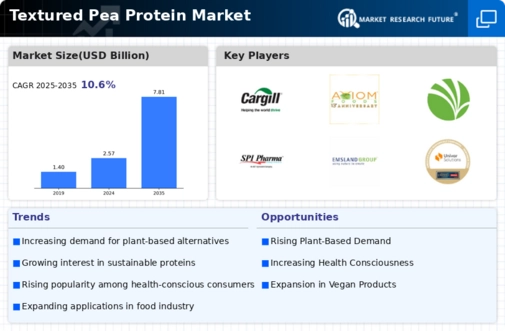Market Growth Projections
The Global Textured Pea Protein Market Industry is poised for substantial growth, with projections indicating a market size of 7.81 USD Billion by 2035. This anticipated growth reflects a compound annual growth rate (CAGR) of 10.63% from 2025 to 2035. Such figures suggest a robust and expanding market, driven by various factors, including rising health consciousness, sustainability trends, and the increasing popularity of plant-based diets. The market's evolution is likely to be characterized by innovation and diversification of product offerings, catering to a wide range of consumer preferences. This growth trajectory underscores the potential for investment and development within the textured pea protein sector.
Innovation in Food Products
The Global Textured Pea Protein Market Industry is propelled by continuous innovation in food products that incorporate textured pea protein. Manufacturers are increasingly developing new formulations and applications, such as ready-to-eat meals, snacks, and dairy alternatives, which cater to diverse consumer preferences. This innovation not only enhances the product range but also attracts a wider audience, including those seeking convenient and nutritious options. As the market evolves, the introduction of novel products is expected to drive growth, with a projected CAGR of 10.63% for the period from 2025 to 2035, indicating a dynamic and responsive market landscape.
Health Benefits of Pea Protein
The Global Textured Pea Protein Market Industry benefits from the recognized health advantages associated with pea protein consumption. Rich in essential amino acids, fiber, and iron, textured pea protein is increasingly favored by health-conscious consumers. Studies suggest that it may aid in muscle recovery and weight management, making it an attractive option for athletes and fitness enthusiasts. As the population becomes more health-aware, the demand for nutritious and functional food ingredients rises. This trend is expected to contribute to the market's growth, with projections indicating a potential market size of 7.81 USD Billion by 2035, reflecting the increasing preference for health-oriented food products.
Rising Demand for Plant-Based Proteins
The Global Textured Pea Protein Market Industry experiences a notable surge in demand for plant-based proteins, driven by increasing consumer awareness regarding health and sustainability. As more individuals adopt vegetarian and vegan diets, the market is projected to reach 2.57 USD Billion in 2024. This shift towards plant-based alternatives is not merely a trend but reflects a broader societal movement towards healthier eating habits. The versatility of textured pea protein in various food applications, such as meat substitutes and protein bars, further enhances its appeal. Consequently, this growing demand is likely to propel the market forward, indicating a robust growth trajectory.
Growing Vegan and Vegetarian Population
The Global Textured Pea Protein Market Industry is significantly impacted by the increasing population of vegans and vegetarians globally. This demographic shift is not limited to specific regions but is observed across various countries, driven by ethical, health, and environmental considerations. As more consumers transition to plant-based diets, the demand for textured pea protein as a meat substitute rises. This trend is expected to sustain market growth, with projections indicating a market size of 2.57 USD Billion in 2024. The expanding vegan and vegetarian population presents a substantial opportunity for manufacturers to cater to this evolving consumer base, thereby enhancing their market presence.
Sustainability and Environmental Concerns
The Global Textured Pea Protein Market Industry is significantly influenced by growing concerns regarding sustainability and environmental impact. As consumers become more conscious of their ecological footprint, the demand for sustainable protein sources rises. Textured pea protein, derived from peas, is considered an environmentally friendly alternative to animal-based proteins, requiring less land and water for production. This sustainability aspect appeals to a broad consumer base, particularly millennials and Gen Z, who prioritize eco-friendly products. The market's growth is likely to be bolstered by this trend, as more companies seek to align their offerings with sustainable practices, thereby enhancing their market position.



















Leave a Comment